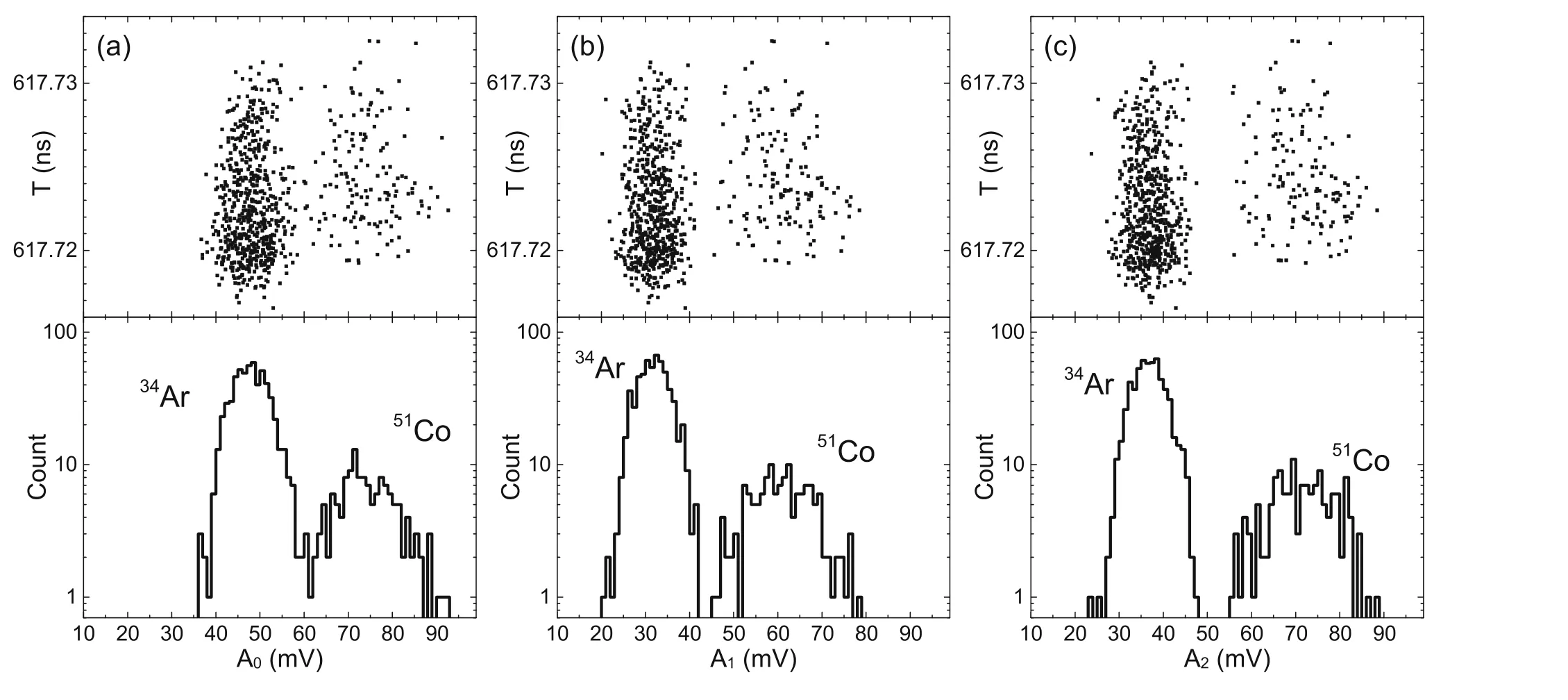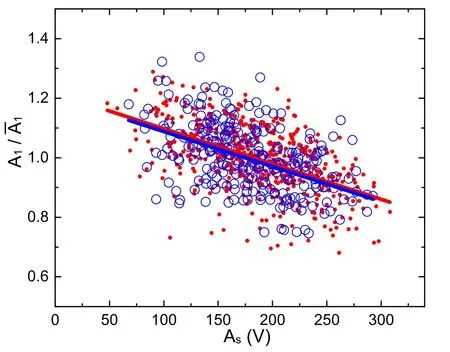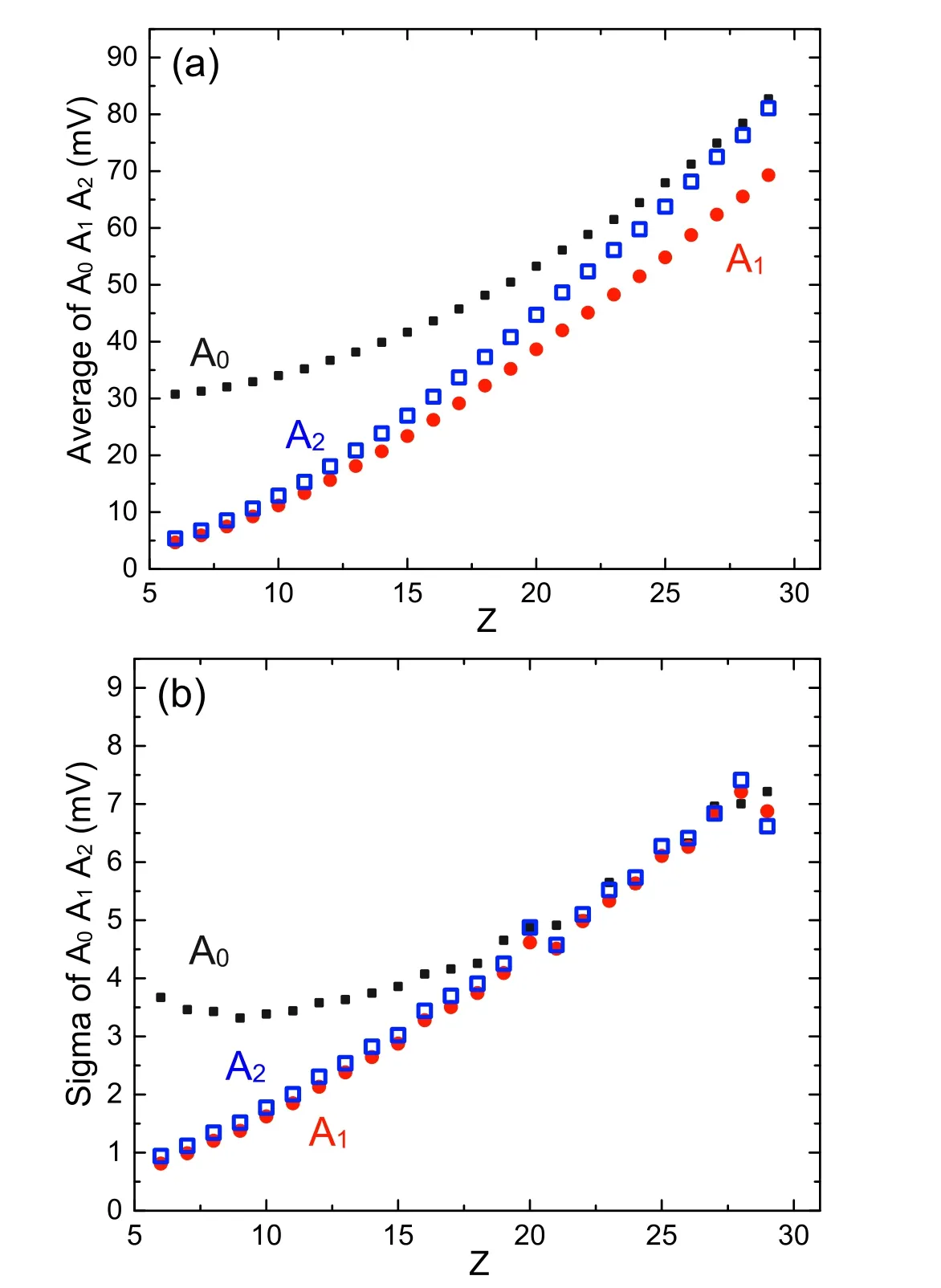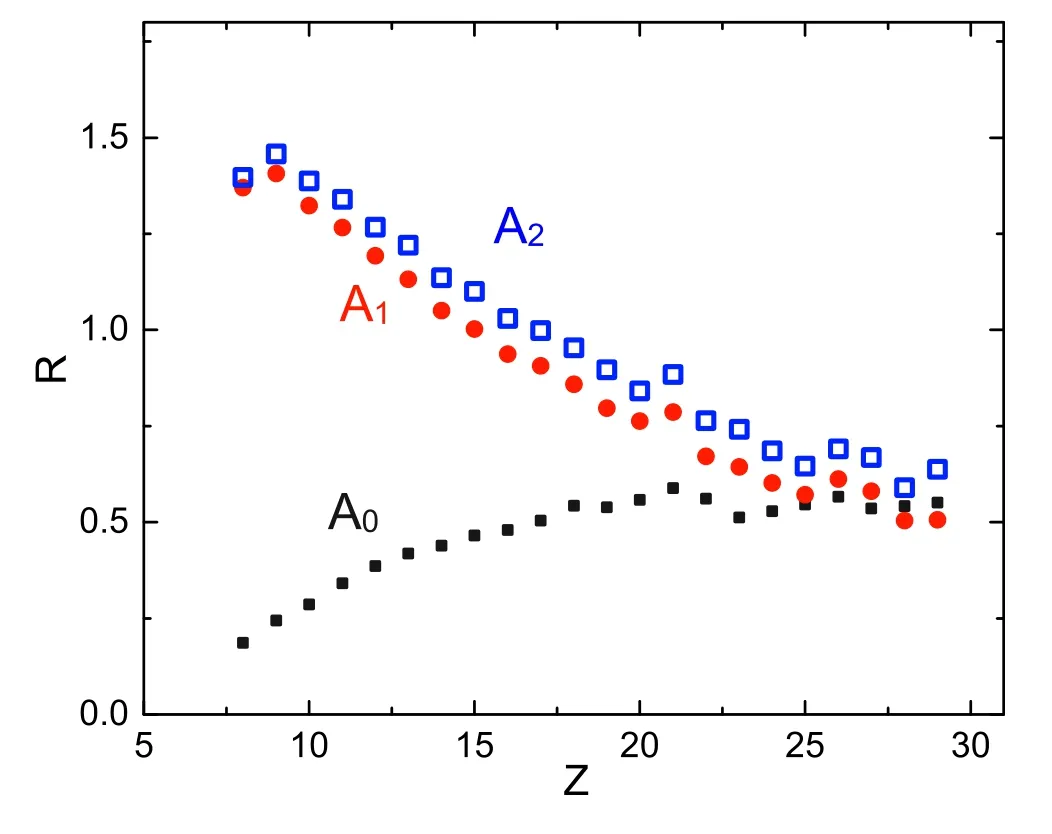Charge resolution in the isochronous mass spectrometry and the mass of 51Co
Xu Zhou· Meng Wang· Yu-Hu Zhang · Hu-Shan Xu ·You-Jin Yuan· Jian-Cheng Yang· Yu. A. Litvinov· S. A. Litvinov ·Bo Mei · Xin-Liang Yan · Xing Xu,5 · Peng Shuai · Yuan-Ming Xing ·Rui-Jiu Chen · Xiang-Cheng Chen · Chao-Yi Fu · Qi Zeng,6·Ming-Ze Sun · Hong-Fu Li · Qian Wang · Tong Bao · Min Zhang ·Min Si,7 · Han-Yu Deng · Ming-Zheng Liu · Ting Liao · Jin-Yang Shi ·Yu-Nan Song
Abstract Isochronous mass spectrometry (IMS) of heavyion storage rings is a powerful tool for the mass measurements of short-lived nuclei. In IMS experiments,masses are determined through precision measurements of the revolution times of the ions stored in the ring.However,the revolution times cannot be resolved for particles with nearly the same mass-to-charge (m/q) ratios. To overcome this limitation and to extract the accurate revolution times for such pairs of ion species with very close m/q ratios, in our early work on particle identification, we analyzed the amplitudes of the timing signals from the detector based on the emission of secondary electrons. Here, the previous data analysis method is further improved by considering the signal amplitudes,detection efficiencies,and number of stored ions in the ring. A sensitive Z-dependent parameter is introduced in the data analysis, leading to a better resolution of 34Ar18+ and 51Co27+ with A/Z =17/9. The mean revolution times of 34Ar18+and 51Co27+are deduced,although their time difference is merely 1.8 ps. The uncorrected,overlapped peak of these ions has a full width at half maximum of 7.7 ps. The mass excess of 51Co was determined to be-27,332(41)keV,which is in agreement with the previous value of -27,342(48) keV.
Keywords Isochronous mass spectrometry · Charge resolution · Signal amplitude · Micro-channel plate · 51Co
1 Introduction
Isochronous mass spectrometry (IMS) of heavy-ion storage rings plays an important role in the mass measurements of short-lived nuclei [1, 2]. There are three storage ring facilities that conduct such experiments worldwide [3–6], namely, the experimental cooler-storage ring (CSRe) in Lanzhou, China; the experimental storage ring (ESR) in Darmstadt, Germany; and the Rare-RI Ring(R3) in Saitama, Japan. In IMS experiments, the nuclei of interest are produced in projectile fragmentation(PF)or in in-flight fission nuclear reactions, where the production cross sections are related to the binding energies of the fragments [7–9]. The reaction products of interest are selected with a fragment separator and injected into the storage ring for mass measurements. The revolution times of the stored nuclides are directly related to their mass-tocharge (m/q) ratios. The revolution times are typically measured by using dedicated timing detectors[10–13].It is obvious that only those revolution times that could unambiguously be assigned to a specific ion species can be used[14, 15].
Particle identification (PID) is a prerequisite in experiments with radioactive ion beams (RIBs) produced in a nuclear reaction and is routinely accomplished along an RIB beam line by measuring the time of flight (TOF),energy loss (ΔE), and magnetic rigidity (Bρ) for each particle [16, 17]. In particular, the atomic number Z is mainly determined by using the ΔE value,which is usually measured with various ionization-type detectors placed along the beam line.
Among the storage-ring-based facilities, the R3 in RIKEN is the only one where a PID within a beam line can be performed [18,19],where the quasi-DC beam from the superconducting cyclotron is employed.Thus,the RIBs can indeed be identified on an event-by-event basis prior to their injection into the R3.It is very different in the cases of the CSRe and ESR.The driver accelerator at the facility in Lanzhou is the heavy-ion synchrotron CSRm [20]. The primary beams are rapidly extracted from the CSRm within~300 ns. Correspondingly, the produced RIBs have a similar bunched structure.Therefore,event-by-event PID is not feasible in the RIBLL2 radioactive-ion beam line connecting the CSRm and the CSRe. A similar situation can be observed at the GSI Helmholtz Centre for Heavy Ion Research in Darmstadt, Germany, where the ions are fast-extracted from the heavy-ion synchrotron SIS-18,analyzed in-flight with the fragment separator FRS, and injected into the ESR for isochronous mass measurements[21]. In this work, we examined the sensitivity of the timing detectors to the charge of the stored ions for the purpose of performing in-ring PID.
Using IMS at the CSRe, we measured the masses of more than 30 short-lived nuclei [22–32]. For a recent review, the reader is referred to Refs. [5, 6, 27] and the references cited therein. In these experiments, the ions were identified almost solely through their m/q ratios by comparing the revolution time spectrum obtained experimentally with the simulated one[14,15].An m/q resolving power of ~3×105was achieved at the CSRe,which was sufficient to identify the isomeric states in101In and52Co[24,28].However,for some pairs of ions with very similar m/q ratios, such as51Co27+and34Ar18+, the revolution times were too close to each other to be resolved clearly.Charge determination can provide crucial information for PID in these cases.Charge-resolved IMS was developed by analyzing the average amplitudes of the signals from the timing detector induced by the stored ions [33]. This method was used successfully to determine the mass of51Co for the first time.Although the charge difference(ΔZ)of51Co27+and34Ar18+was relatively large, some events could not be unambiguously identified because of the limited charge resolution in a previous study [33].
A higher charge resolution is desired. For example, the masses of54,56Ti nuclides were measured in an earlier experiment at the CSRe [23, 29]. The55Ti nuclide must have been produced in significant amounts in this experiment according to the yields of the neighboring nuclei;however, it could not be separated from50Ca. To measure the mass of55Ti,we need to resolve55Ti22+and50Ca20+by charge, where ΔZ is only 2. Such high charge resolution was not realized in that experiment. Owing to the limited charge resolution, mass measurements of N =Z nuclides with conventional IMS at the CSRe or ESR are usually regarded as unfeasible. The N =Z nuclides with ΔZ =2 must be resolved by charge, whereas the neighboring N =Z (ΔZ =1) nuclides can be resolved by their revolution times because the difference in their m/q ratios is sufficiently large, owing to the odd-even staggering of the binding energies. If ions with ΔZ =2 can be resolved by charge,then,in principle,all nuclides can be identified and measured in IMS experiments.
PHC桩预应力高强混凝土桩桩身强度高,桩身质量稳定可靠,穿透力强,便于施工。静压施工时,施工现场简洁,无污染、无噪声,能保证文明施工。
In this paper, we describe a new method in which the detailed characteristics of the timing detector are considered in the data analysis.The charge resolution of the IMS was improved significantly, leading to a complete separation of34Ar and51Co. Possible future developments are discussed as well.
2 Experiment and the timing detector
The following discussions are based on the same experimental data that were analyzed in an earlier study[33]. More details about the experiment can be found in Refs. [33–35]. This experiment aimed to measure the masses of Tz=-3/2 nuclei in the pf shell. The nuclei of interest were produced using a projectile fragmentation of 463 MeV/u of58Ni19+primary beams in a ~15-mm9Be production target. At this energy, the fragments emerged from the target predominantly as bare ions. Therefore, in the following, we assume the atomic charge q to be equal to the atomic number Z.The RIBLL2 and CSRe were set to a fixed magnetic rigidity of Bρ=5.677 Tm.All fragments within the Bρ acceptance of ~±0.2% were injected into the CSRe.
The revolution times of the stored ions were measured by using a timing detector equipped with a carbon foil of 19μg/cm2in thickness and 40 mm in diameter [11]. The foil was positioned in the circulation path of the stored ions. When an ion passed through the carbon foil, secondary electrons were released from the foil surface and guided isochronously to a set of micro-channel plates(MCP) in the Chevron configuration [36]. The MCP had the same diameter as that of the carbon foil,and the microchannels were 5 μm in diameter. When an electron hit a channel of the MCP, an avalanche of further secondary electrons propagated through the channel. A bunch of electrons exiting from the rear side of the channel was collected by a conical anode. A signal can be generated with the activation of one or more channels.The negativevoltage signal was directly transmitted from the anode to a digital oscilloscope for data acquisition. The recording time was 200μs for each injection in this experiment.
The number of electrons from the carbon foil induced by an ion was roughly proportional to the energy loss, which scales with q2=Z2[11]. Consequently, both the average signal amplitude(A0)and the detection efficiency(η)of an ion depended strongly on its atomic number Z.
Figure 1a shows a two-dimensional plot of the revolution time T versus A0obtained in the experiment, and this plot is similar to that in Fig. 3 given in an earlier work[33].The51Co27+and34Ar18+ions can be resolved using the A0value, albeit not completely separated. Figure 1a is an analogue of the typical PID plots at an in-flight separator[16,17],although with a lower charge resolution but with a higher m/q resolution. Figure 1b shows a two-dimensional plot of the revolution time T versus η. The two plots in Fig. 1 are quite similar. It seems that A0provides a better charge resolution for heavier ions, whereas η provides a better charge resolution for lighter ones.

Fig. 1 (Color online) Two-dimensional plot of the average signal amplitudes A0 (a)and the detection efficiencies η(b)as a function of the revolution time T for Tz =-1/2 (black labels), Tz =-1 (red labels), and Tz =-3/2 (blue labels) ions
3 Analysis of the signal amplitudes
In an earlier study, the average signal amplitude (A0)was used to resolve the51Co27+and34Ar18+ions [33].Figure 2a shows a scatter plot of the revolution time T versus A0and the projected histogram for34Ar and51Co.Although the two ion species can be well resolved, there still exists an overlap between the two Gaussian-like distributions.
Assuming that each microchannel was fully discharged after the electron impact and thus provided the same contribution to the signal, we found that A0was roughly proportional to the average number of activated microchannels and,in turn,to the number of secondary electrons released from the foil surface. However, there were ion passages through the detector, which did not generate signals. This reflects the finite detection efficiency η [33], which includes electron hits in between the channels(geometrical efficiency) and hits into the already discharged channels(dynamic efficiency). We define an average signal amplitude corrected by the total efficiency as A1:

Fig.2 Scatter plot of the revolution time T as a function of A0 (a), A1 (b), and A2 (c), and the projected histograms for the 34Ar and 51Co ions

Clearly, A1is proportional to the total number of microchannels activated by an ion.Figure 2b shows a scatter plot of the revolution time T versus A1and the projected histogram for34Ar and51Co. It can be seen clearly from the figure that the separation of these two ions became better.
After a micro-channel was activated to output the avalanche electrons, it took ~10 ms to recharge the channel.During this period, the channel did not respond to other coming electrons. Because the measurement time is much shorter than the recharging time, each micro-channel can be used at most once during the measurement [37]. If the number of stored ions is too large for one injection into the CSRe, the total number of activated microchannels would be large and the chance for each electron to activate a microchannel would be reduced,leading to reduced A0and η values.This dynamic efficiency obviously depends on the number of stored ions and their charge.The sum amplitude of all signals(As)was a direct measure of the total number of activated channels in one injection. Thus, it is expected that the A1values have a negative correlation with the As values for one ion species.

Fig. 3 (Color online) For the 36K (blue empty circles) and 53Ni (red solid circles) ions, a plot of the constructed parameter A1 values divided by the mean value A1 for such ion species as a function of the sum amplitude of all signals in one injection (As)
In the present experiment, the number of stored ions ranged from 2 to 46 in various injections, with the most probable value being 21. The Asvalues ranged from 50 to 300 V. The relationship between the A1and the Asvalues was similar for all ion species, as shown in Fig. 3 for the example of the36K and53Ni ions, which can be clearly identified using their revolution times.The mean ¯A1values are calculated for these two ion species. The A1/¯A1ratios are calculated for each individual ion, and a scatter plot of A1/¯A1versus As is shown in Fig. 3. The A1/¯A1values for both ion species are described by a linear function of As.The two slopes obtained are very similar, indicating a constant slope for all the ion species. If the observed correlation of A1and Asvalues is considered, the charge resolution can be improved.
A new parameter A2is defined as an estimate of the A1value at As=0 V. The A2value is proportional to the number of channels that should be activated by the ion if all the micro-channels are available. Thus, it is directly related to the number of electrons released from the detector foil owing to this ion. Considering the constant slope for different ion species, as shown in Fig. 3, we can calculate the A2value as

Here,the parameter B represents the slope shown in Fig. 3 and is determined by using all ion species with a proton number of Z >8 and more than 100 counts. It is equal to B=-9.05(7)×10-4V-1. Figure 2c shows a scatter plot of the revolution time T versus A2and the projected histogram for34Ar and51Co ions. It can be seen from the figure that the two ions are completely separated.
Because the revolution time T is Bρ dependent on the ions of34Ar and51Co[3,4],the T values should depend on the average passage position of the ions through the detector. As shown in Fig. 2, the values of A0, A1, and A2have no correlation with the revolution time T,proving the position independence of A0,A1,and A2in this experiment.
Using A2for the PID,we determined the mass excess of51Co to be -27,332(41) keV, which is in agreement with the previously obtained value of -27,342(48) [33]. The smaller mass uncertainty in this analysis was mainly due to the larger statistics obtained under less strict constraints.In an earlier work[33],only the particles that were stored for more than 300 revolutions in the CSRe were used in the analysis. Using the improved data analysis methods, we lowered the threshold in the present work to 80 revolutions,thus increasing the statistics.
4 Charge resolution
The A0, A1, and A2values were calculated for all ions.Figure 4a shows the average values of these three parameters for ions with the same proton number Z. As can be seen in the figure, the A1and A2values are very similar,whereas A0is larger than the other two parameters for lighter ions. A2increases rapidly with the proton number and approaches A0.It is evident that A2is more sensitive to proton number Z. The standard deviations of these three parameters are shown in Fig. 4b as a function of Z. For heavy ions (Z ~20), they are similar for all three parameters,whereas for lighter ions,the standard deviation of A0is considerably larger.

Fig.4 (Color online)For ions with the same proton number Z,a plot of the average (a) and standard deviations (b) of A0 (black solid squares), A1 (red solid circles), and A2 (blue empty squares) as a function of Z
The charge resolution ratio R was introduced to represent the separation of the two ion species. R is defined as

where A indicates the parameters used in the charge identification, Z is the proton number, and ΔZ is the proton number difference between the two ion species. For the normal distribution, two peaks can be resolved if R ≥2,corresponding to less than 2.5% of the events from one peak that overlap with those of another peak.In the case of R=1, two peaks can be identified with ~16% overlapping events.
Figure 5 shows the charge resolution ratios for different pairs of ions with ΔZ =2.The charge resolution ratios for A2(R(A2))were the largest for all ions,with an increase of 10%–650% as compared with those for A0. The A2parameter provided the highest charge resolution.With the use of the A2values in the calculation, Fig. 6 shows the R(A2)for pairs of ions with various ΔZ values as a function of Z.

Fig. 5 (Color online) For groups of ions with a proton number difference ΔZ of 2, a plot of the charge resolution ratios R using A0(black solid block),A1 (red solid dot),and A2 (blue hollow block)as a function of proton number Z
The R values are directly related to ΔZ/Z. In this experiment,pairs of ions with ΔZ/Z >0.22 can be clearly resolved.
Only a moderate charge resolution was achieved in this experiment because the charge resolution was not particularly optimized.A better charge resolution can be realized with several technical improvements. The charge resolution can be improved by extending the recording time for each injection, i.e., from the present 200 μs to 400–600 μs. A lower number of stored ions in an individual injection will also lead to a higher resolution. Two timing detectors, a new IMS method that is under development and which will be applied in future experiments at the CSRe [12, 29, 38–41], could also increase the charge resolution.Finally,MCP plates with 2 μm of pore size will be adopted, thus boosting the number of microchannels.
5 Summary
In the IMS experiments, charge resolution provides crucial information for the particle identification of ion pairs with m/q ratios that are too similar to be resolved by their revolution times. In an earlier study, a charge-resolved IMS was developed at the CSRe to resolve the51Co27+and34Ar18+ions.However,the two ion types were not completely separated owing to the limited charge resolution. In this paper, a new analysis method is presented that explicitly considers the average signal amplitudes,detection efficiencies,and number of stored ions in the data analysis. The charge resolution of the IMS was significantly improved for ions with a proton number of Z<22,leading to a complete separation of34Ar and51Co. The mass excess of51Co was determined to be -27,332(41)keV, which is in agreement with the value obtained in a previous work [33]. The developed analysis method may be of broader interest for storage ring-based atomic andnuclear physics experiments using similar types of detectors.

Fig. 6 (Color online) With the use of the constructed parameter A2 in the calculation, a plot of the charge resolution ratios R as a function of proton number Z for groups of ions with ΔZ =2 (black solid block), ΔZ =4(green solid dot), ΔZ =6 (red hollow dot), and ΔZ =8 (blue hollow block)
Author ContributionsAll authors contributed to the study conception and design. Material preparation, data collection and analysis were performed by Xu Zhou, Meng Wang,Yu-Hu Zhang,Xin-Liang Yan and Peng Shuai. The first draft of the manuscript was written by Xu Zhou and all authors commented on previous versions of the manuscript. All authors read and approved the final manuscript.
 Nuclear Science and Techniques2021年4期
Nuclear Science and Techniques2021年4期
- Nuclear Science and Techniques的其它文章
- Design, fabrication, and cold test of an S-band high-gradient accelerating structure for compact proton therapy facility
- Simulation of proton-neutron collisions in inverse kinematics and its possible application
- Sinogram denoising via attention residual dense convolutional neural network for low-dose computed tomography
- Secondary and activated X(γ)radiation of SPHIC particle therapy facility
- Analysis of influencing factors on the method for determining boron concentration and dose through dual prompt gamma detection
- Development of a seven-cell S-band standing-wave RF-deflecting cavity for Tsinghua Thomson scattering X-ray source
